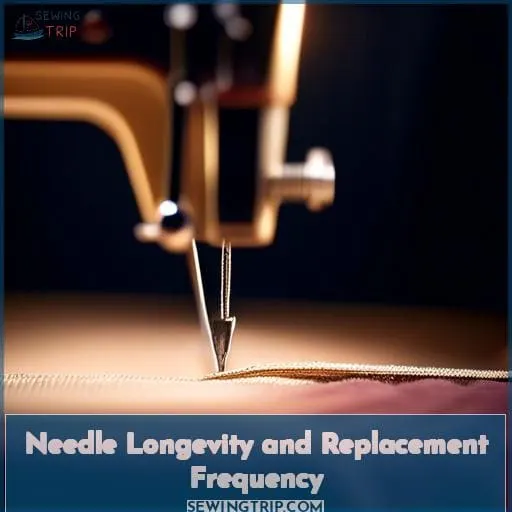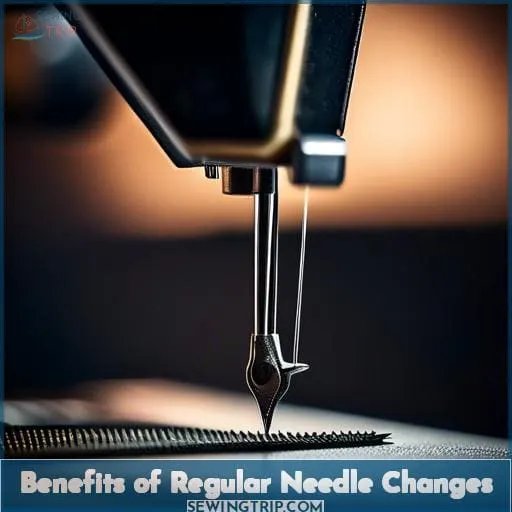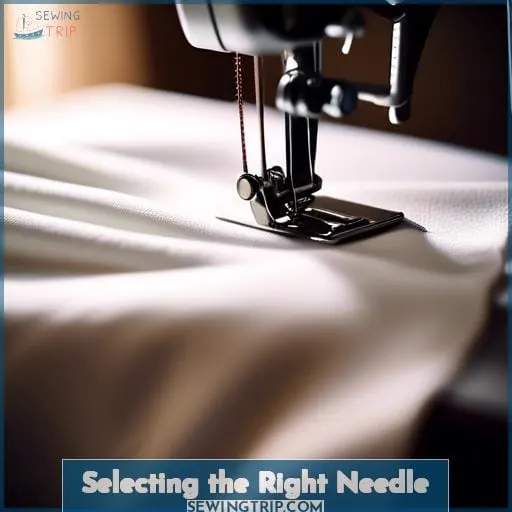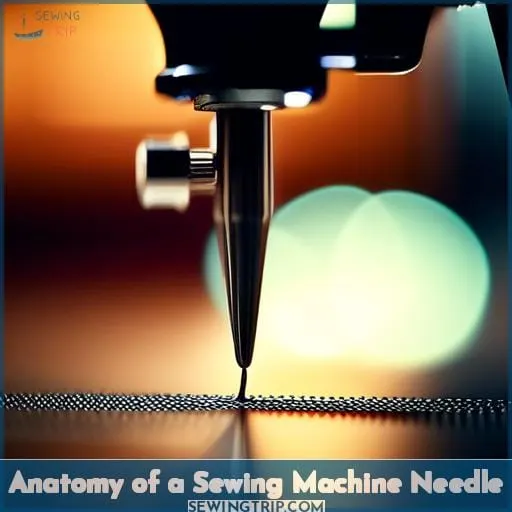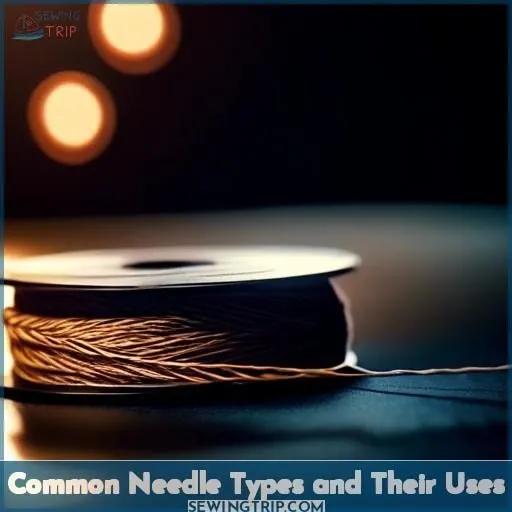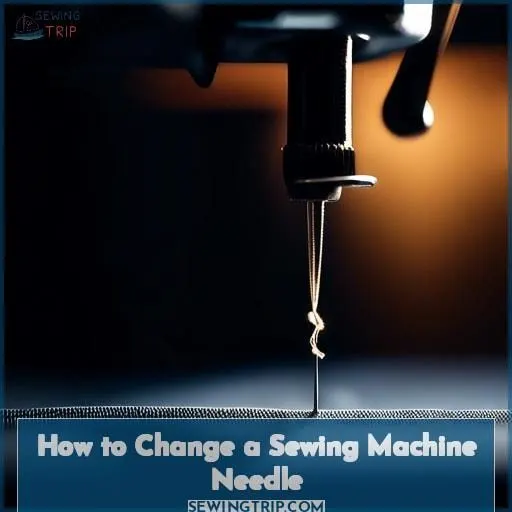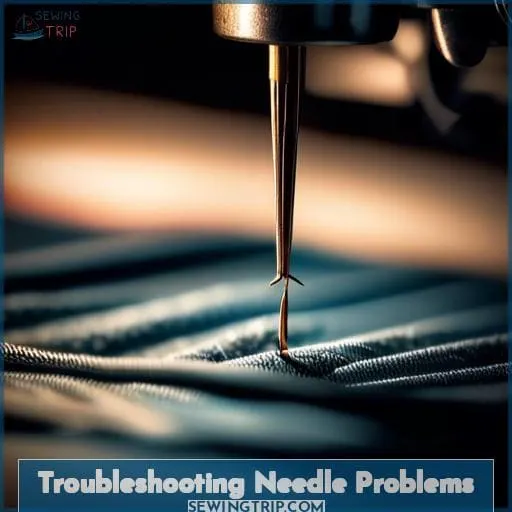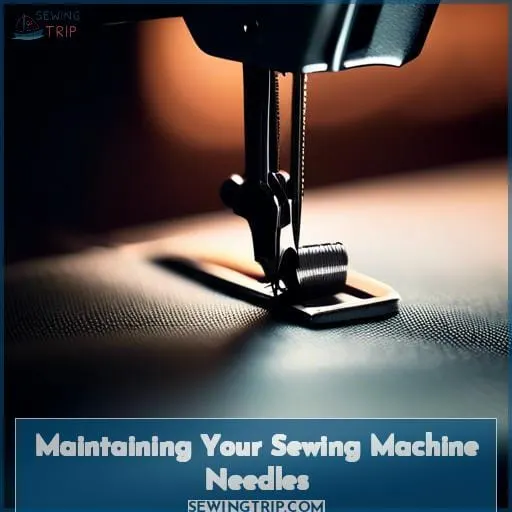This site is supported by our readers. We may earn a commission, at no cost to you, if you purchase through links.
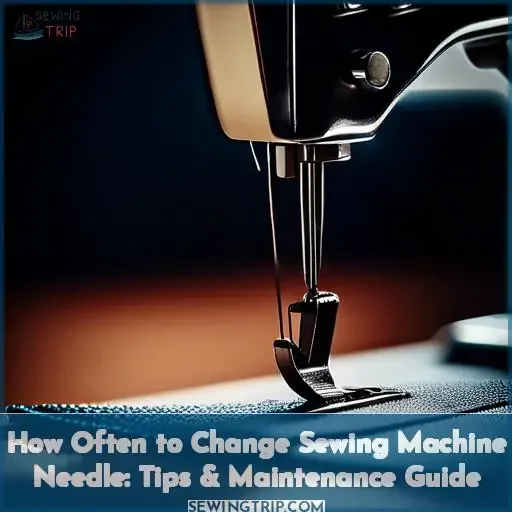
This guide dives deep into the technical aspects and practical experiences of needle maintenance, offering tips for recognizing when it’s time for a change.
Whether you’re dealing with thread issues or irregular stitching, we’ll show you how to select the right needle and keep your sewing projects running smoothly.
Let’s master the art of needle maintenance together.
Table Of Contents
- Key Takeaways
- How Often Should You Change Your Sewing Machine Needle
- Needle Longevity and Replacement Frequency
- Signs Your Needle Needs Changing
- Benefits of Regular Needle Changes
- Selecting the Right Needle
- Anatomy of a Sewing Machine Needle
- Common Needle Types and Their Uses
- How to Change a Sewing Machine Needle
- Troubleshooting Needle Problems
- Maintaining Your Sewing Machine Needles
- Advanced Tips for Needle Maintenance
- Frequently Asked Questions (FAQs)
- Conclusion
Key Takeaways
- Replace your sewing machine needle every project or after approximately 5-6 hours of stitching to ensure optimal performance and stitch quality.
- Choose the right needle for your fabric type: universal needles for general sewing, stretch needles for stretchy fabrics, Microtex needles for delicate fabrics, and jeans needles for tough denims.
- Regularly changing your sewing machine needle can prevent thread breaking or knotting, reduce skipped stitches, and improve fabric handling, ultimately extending the life of your sewing machine.
- Be attentive to signs of needle wear such as irregular stitching, bent or rusty needles, and ensure needles are lubricated and stored safely when not in use.
How Often Should You Change Your Sewing Machine Needle
You should change your sewing machine needle every 8 hours of sewing to prevent issues like skipped stitches and fabric damage.
Needle Longevity and Replacement Frequency
You’ve likely wondered how often you should switch out your sewing machine needle. It’s crucial to tailor this frequency to the fabric you’re working with for optimal results.
Ideal Replacement Timelines
You know the drill: swap out that sewing machine needle every project or after 5-6 hours of stitching. It’s not just about avoiding needle damage; it’s about matching needle type and size to your fabric’s durability and thread compatibility.
Keep that needle sharpness on point, and your sewing machine will thank you with flawless seams every time.
Adjusting Frequency Based on Fabric Type
After mastering the basics, it’s time to fine-tune your needle change strategy based on fabric weight. Heavier fabrics like denim demand a sturdier needle, increasing wear and shortening its lifespan. Conversely, delicate silks are kinder, allowing longer needle use. Remember, a mismatch can lead to skipped stitches or thread snags.
Signs Your Needle Needs Changing
If you’re noticing irregular stitching or thread issues, it’s likely time to change your sewing machine needle. These signs indicate dullness or damage, impacting your sewing quality and machine performance.
Irregular Stitching
If you’re noticing your stitches have taken a nosedive in quality, it’s a telltale sign your needle might be throwing in the towel.
- Check for needle sharpness; a blunt tip can lead to a stitch apocalypse.
- Bent needles are no-go; they’re the culprits behind your sewing rebellion.
- Rusty needles? They’ll taint your fabric’s runway dreams.
- Smart needle storage keeps your pointy friends ready for action.
- Responsible needle disposal ensures your sewing saga continues safely.
Thread Issues
Just tackled irregular stitching? Now, let’s dive into thread woes.
If your thread’s breaking or knotting like it’s plotting against you, your needle might be the culprit. Keep those needles slick with proper lubrication and stashed safely when not in use.
Benefits of Regular Needle Changes
Regularly changing your sewing machine needle can significantly improve your stitch quality.
Enhanced Stitch Quality
Just as a dull knife mangles a tomato, a worn needle can butcher your stitch quality.
Regular swaps ensure each fabric slice is clean, with needle size and point tailored to the task.
The right eye shape and groove design play their part, too, while a snug shank length keeps your needle orientation true.
Don’t let a misfit needle shank your project!
Extended Machine Life
Just as a sharp knife is a chef’s best friend, a fresh sewing machine needle is your secret to impeccable stitch quality. Regular swaps not only keep your stitches looking top-notch but also contribute to your machine’s durability.
Think of it as routine maintenance for optimal performance, ensuring your fabric glides smoothly and your sewing tips stay sharp—no frayed threads or needle scars here!
Selecting the Right Needle
Selecting the right needle for your sewing project is crucial for achieving the best results. Understanding needle sizes and types tailored to different fabrics ensures your machine performs optimally.
Needle Types for Different Fabrics
Choosing the right sewing machine needle for your fabric is like picking the perfect spice for your dish—it makes all the difference.
- Universal needles for your everyday sewing adventures.
- Stretch needles to glide through your stretchy fabrics without a hitch.
- Microtex needles for those delicate silks and satins.
- Jeans needles to tackle tough denims like a pro.
- Overlock needles for serger magic.
Understanding Needle Sizes
Diving into needle sizes feels like decoding a secret language, but it’s your ticket to sewing success. Think of it as matching the right tool for the job. A fine needle for silks, a sturdy one for denim.
Remember, changing your needle every few projects keeps stitches crisp. Keep them organized and sharp; your sewing machine will thank you.
Anatomy of a Sewing Machine Needle
Just as you wouldn’t use a butter knife to slice a tomato, you can’t expect one needle to tackle every fabric.
The anatomy of a sewing machine needle is key to this precision. The needle point is your fabric’s first contact—it has to be sharp to pierce without snagging.
Then there’s the needle blade, the unsung hero that determines the size of the stitch holes.
The needle eye cradles the thread, while the needle groove guides it like a dance partner, ensuring smooth moves and no tangles.
Lastly, the needle shank keeps everything steady, connecting to your machine with a satisfying click. Remember, a well-chosen needle transforms sewing from a chore into a high-flying craft.
Common Needle Types and Their Uses
Transitioning from the anatomy of a sewing machine needle, let’s dive into the diverse world of needle types and their specific uses. Selecting the right needle can feel like picking the perfect arrow for your quiver—vital for hitting the mark on your sewing projects.
- Needle selection is crucial; using a Jeans needle for silk can be like using a sledgehammer for a nail—overkill and potentially disastrous.
- Needle storage and inspection are your best friends. A bent needle is a no-go, akin to driving with a flat tire. Regular checks for needle sharpness ensure your sewing machine runs smoothly, avoiding the dreaded snag or skip in your fabric masterpiece.
How to Change a Sewing Machine Needle
After exploring the various needle types and their specific uses, it’s crucial to know how to switch them out effectively. Changing your sewing machine needle is a simple yet vital task that ensures your projects turn out beautifully.
- Needle Lubrication: A drop of oil can make insertion smoother.
- Needle Storage: Keep them organized in a labeled case to avoid mix-ups.
- Needle Disposal: Use a dedicated sharps container for safety.
- Needle Sharpness Tester: Regularly check if it’s time for a change.
Troubleshooting Needle Problems
If you’re experiencing skipped stitches, puckering, or thread breakage, it’s likely time to check your needle. A blunt or incorrect needle can cause these issues, impacting your sewing project’s quality.
Skipped Stitches
Just swapped your needle but still facing skipped stitches? It’s like trying to solve a puzzle with a piece missing. Let’s dive into the common culprits: needle damage, fabric wear, tension woes, and thread quality.
| Cause | Solution |
|---|---|
| Needle Damage | Replace with new needle |
| Fabric Wear | Adjust sewing speed |
| Tension Adjustment | Check machine manual |
| Thread Quality | Upgrade to high-quality thread |
Puckering and Thread Breakage
Just tackled skipped stitches and now your fabric’s puckering or the thread’s shredding like cheese on a grater? It’s a sign your needle’s blunt or bent. Listen for that telltale clicking sound—your machine’s cry for help. Swap out that needle before it turns your project into a ragged mess.
Maintaining Your Sewing Machine Needles
After tackling needle troubles, let’s dive into keeping those needles in tip-top shape.
Needle Storage: Keep ’em organized and protected. A dedicated needle case or a labeled box can prevent mix-ups and protect points from damage. Think of it as a needle hotel; every size and type gets its own cozy room.
Needle Disposal: Don’t just toss them in the trash. Use a small, clearly marked container to safely dispose of old needles. It’s like giving them a respectful send-off.
Needle Cleaning and Sharpening: A gentle wipe with a soft cloth keeps them clean. For sharpening, though, consider this: most needles are more replace than repair. It’s like trying to sharpen a toothpick—possible, but why not just grab a new one?
Advanced Tips for Needle Maintenance
Diving into the nitty-gritty of needle maintenance, you’ll want to keep your sewing game sharp as a tack.
- Needle Storage: Keep ’em organized and protected. A dedicated case prevents jumbled messes and accidental dulling.
- Needle Sharpening: No more snagging fabrics! A needle hone or emery pad can revive those points, but don’t overdo it—over-sharpening can weaken them.
- Needle Cleaning: A stitch in time saves nine, right? Regularly wipe your needles with a soft cloth to remove any built-up gunk.
- Needle Lubrication: A drop of oil on the needle bar means smoother sewing and less wear and tear.
Frequently Asked Questions (FAQs)
Can dull needles affect fabric tension?
Yes, dull needles can throw your fabric tension off balance, leading to skipped stitches and puckering.
Does needle brand impact sewing quality?
Yes, needle brand can impact sewing quality. Different brands may offer unique features that cater to specific fabrics or sewing tasks, enhancing stitch precision and fabric handling for a top-notch sewing experience.
Are titanium needles superior to regular ones?
Titanium needles aren’t just tough; they’re marathon runners in the needle world, outlasting regular ones by miles with their durable titanium nitride coating, perfect for high-speed sewing without losing their sharp edge.
How does needle thickness influence stitch formation?
Needle thickness directly impacts your stitch’s quality; thicker needles punch larger holes, affecting fabric integrity and stitch appearance. It’s a balancing act—choose wisely to avoid a threadbare look or weakened seams.
Can a needle affect sewing machine speed?
Absolutely, a needle can impact your sewing machine’s speed! A dull or incorrect needle can cause drag, leading to slower sewing and potential thread breakage or fabric damage.
Conclusion
Navigating the needle’s journey, you’ve stitched together the essentials of sewing machine maintenance.
Keep those needles fresh, and your creations will thank you for it.
Now, go forth and sew with confidence, knowing you’ve got the point on needle care!

